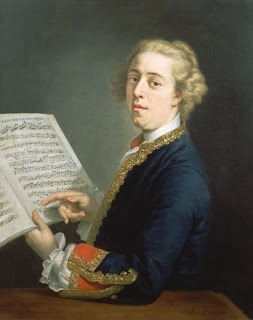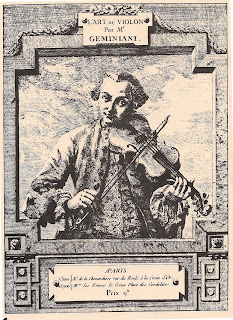Tuscan played alongside Handel in court of George I
 |
| Francesco Geminiani moved to London in 1714 and settled there |
Although he composed many works and at his peak was renowned
as a virtuoso violinist, he is regarded as a significant figure in the history
of music more for his writings, in particular his 1751 treatise Art of Playing
on the Violin, which explained the 18th-century Italian method of violin
playing and is still acknowledged as an invaluable source for the study of
performance practice in the late Baroque period.
Geminiani himself was taught to play the violin by his
father, and after showing considerable talent at an early age he went to study the
violin under Carlo Ambrogio Lonati in Milan, later moving to Rome to be tutored
by the aforementioned Corelli.
Returning to Lucca, he played the violin in the orchestra at
the Cappella Palatina for three years, after which he moved to Naples to take
up a position as Leader of the Opera Orchestra and concertmaster.
He was by that time recognised as a brilliant violin
virtuoso, although his tendency to improvise off the cuff posed problems at
times for the orchestra, who had difficulty in following him. He acquired the nickname Il Furibondo – the
Madman. Some of his violin sonatas were so challenging that only a few of his
contemporary violinists dared to play them in public.
 |
| The cover from a French edition of Gemianini's treatise on how to play the violin |
Handel, like Geminiani, had studied under Corelli and had
introduced London to Italian musical style and. In 1714 Geminiani decided he
would try his luck there too.
His accomplished performances soon attracted patronage,
including that of William Capel, the third Earl of Essex, who would become a
regular sponsor and whom he taught to play. Capel at one time had to rescue Geminiani
from prison, the consequence of debts run up through art
dealing and collecting.
It was through the Earl of Essex that Geminiani was invited
to play his violin concerti in front of George I, with Handel accompanying him
on harpsichord.
He established himself in London as the leading master of
violin-playing, making a good living through his concerts, his published
compositions and his theoretical treatises.
He also taught music and many of his students went on to have successful
careers.
Gemianini is best known for his concerti grossi – a form of Baroque
music that involves an orchestra and a small group of soloists, as opposed to
the single soloist of a solo concerto – of which there were 42. He also
reworked some of Corelli’s pieces as concerti grossi.
Geminiani spent time in Paris and Dublin but preferred to make
his permanent home in London rather than return to Italy. It was during a visit to Dublin that he died in 1762
at the age of 74. He was buried in the
Irish capital but his remains were later reburied in the church of San
Francesco in Lucca.
Lucca is situated in western Tuscany, just 30km (19 miles) inland
from Viareggio on the coast and barely 20km (12 miles) from Pisa, with its
international airport. It is often
overlooked by travellers to the area in favour of the Leaning Tower and the art
treasures of Florence, 80km (50 miles) to the east, yet has much to recommend
within its majestic walls, where visitors can stroll along narrow cobbled
streets into a number of beautiful squares, with lots of cafes and restaurants
for those content to soak up the ambiance but also a wealth of churches,
museums and galleries for those seeking a fix of history and culture. The Renaissance walls, still intact, are an
attraction in their own right, providing a complete 4.2km (2.6 miles) circuit
of the city popular with walkers and cyclists.
Lucca has a rich musical tradition of which Francesco
Geminiani is just part. The city’s main claim to musical fame is as the home of
the great opera composer Giacomo Puccini, who was born there in 1858. Visitors
can look around the house where the composer was born in Corte San Lorenzo, off
Via di Poggio in the city centre, which is now a museum, or his villa on the
shores of nearby Lago di Massaciuccoli, on the way to Viareggio, while there
are daily Puccini concerts throughout the summer in Lucca at the church of Santi Giovanni
e Raparata in Piazza San Giovanni. The composers Alfredo Catalani and Luigi
Boccherini were also from Lucca.



